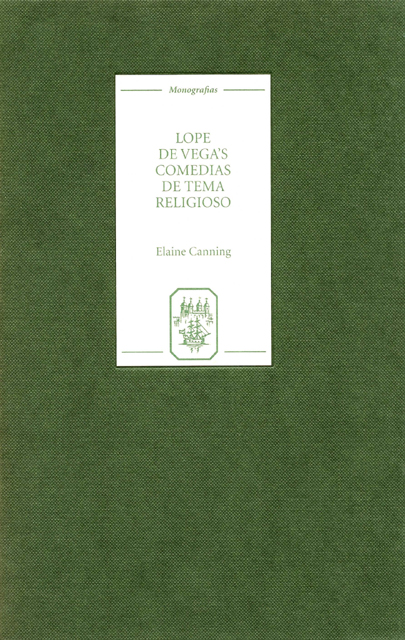Introduction
Published online by Cambridge University Press: 04 May 2023
Summary
While the secular drama of Lope Félix de Vega Carpio (1562–1635) has attracted much critical attention, his comedias de tema religioso constitute a corpus of his works which has been largely neglected. Traditionally, Lope de Vega’s religious plays have been analysed and categorised in terms of their biblical or hagiographical content alone. Ménendez y Pelayo, for example, divides them into two groups – Comedias de asuntos de la sagrada escritura, and Comedias de vidas de santos – and does not attempt to study them beyond their religious framework. It is possible that works like that of Menéndez y Pelayo, which are preoccupied solely with lo religioso, have discouraged critics of Golden Age drama from exploring the many other possibilities that Lope’s comedias de tema religioso may offer to comedia scholarship.
Since the publication of Menéndez y Pelayo’s Estudios, some attempts have been made to redress the scant regard paid to these plays. In 1935, José Montesinos stressed that Lope’s religious drama was deserving of further critical attention – ‘El teatro religioso de Lope no ha sido objeto de atento estudio, aunque lo merecía’. However, very few scholars rose to this challenge and those that did tended to concentrate on Lope’s hagiographical drama. Principal among them are Garasa, Aragone Terni, Dassbach and Morrison. In Santos en escena, Garasa provides a summary of twenty-seven plays, together with a general analysis of three aspects of Lope’s principal hagiographical works. Specifically, he examines the role of the angel and the demon, the presentation of supernatural interventions and miracles and the development of the themes of virtue and sin. The fundamental characteristics of the genre are examined by Aragone Terni in Studio sulle “Comedias de Santos” di Lope de Vega, which includes a classification of twenty-eight of Lope’s plays as hagiographical works. In addition, Aragone Terni discusses the opposition which the comedia de santo generated in seventeenth-century Spain, primarily because of its use of stage machinery. She also explores the use of amorous and comical elements in Lope’s religious drama. Dassbach conducts a comparative study of the hagiographical plays of Lope, Tirso and Calderón in her work, La comedia hagiográfica del Siglo de Oro español. She is concerned not only with an identification of types of saints, but also with the ‘espectacularidad escénica’ produced by the incorporation of supernatural features into the comedia de santo, as well as the function of the sub-plot and the gracioso.
- Type
- Chapter
- Information
- Publisher: Boydell & BrewerPrint publication year: 2004



